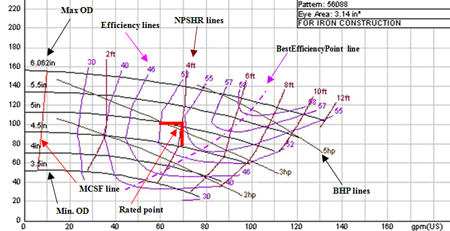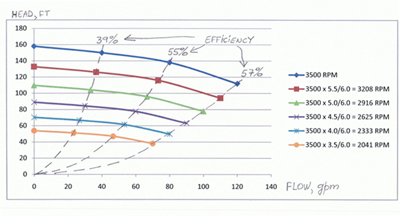The simplest way to change pump flow is to throttle the discharge by the valve. Even in this situation, the impeller diameter cannot be arbitrarily chosen. The diameter should be selected to ensure that the pressure (head) is not excessive, and the power consumed is just enough to provide the required coverage for the anticipated flow range, but not excessively high to overload the motor.
Impeller size selection is straightforward and can be easily found in manufacturer manuals (see Figure 1 for an example). Figure 1 shows pump performance curves at several impeller trims. Such representation is called a combined curve (versus a single line curve) and is intended to help the pump user select the appropriate impeller diameter for the rated point (and around it) and evaluate efficiency, power and NPSHR.

Figure 1. Pump performance curve at various impeller trims. (Courtesy of ITT Goulds Pumps)
Unfortunately, if the conditions of service change to require more flow and head than originally specified, the trimmed impeller size would limit such flexibility. For example, moving to 100 gpm and 120 ft of head for a rated point of 70 gpm at 100 ft (as shown in Figure 1) is impossible; the 5.12 in trimmed impeller would not allow it.
Changing the operating conditions by a variable speed drive, however, can be a flexible alternative (see Figure 2). Inefficiently throttling the valve to change the flow is unnecessary, and the entire range of flow and head expands dramatically.
How would one determine the required pump's speed if a flow range equivalent to that in Figure 1 is desired? The Affinity Laws come to the rescue. Each operating flow-head point scales up or down by simply multiplying the flow by the ratio of the diameter (or speed) and the head by the square of that ratio. This is how Figure 2 is constructed. In our example, several points on the H-Q curve shown in Figure 1 are picked-for example, 0, 40, 80 and 120 gpm, with heads at these points being 158, 150, 138 and 112 ft.

Figure 2. Hydraulic coverage similar to the impeller trim method can be easily estimated using the Affinity Laws and applying a variable speed drive.
If we wanted to make the new speeds correspond to exactly the same impeller diameters given in Figure 1 (6, 5.5, 5.0, 4.5, 4.0 and 3.5 in), we simply calculate the speed ratios corresponding to the ratios of the impeller trim at a given curve to the impeller diameter at the maximum OD.
The main advantage of the VFD, however, with regard to efficiency and energy savings is that efficiency essentially remains the same for a given "scale-down" of speed. Trimming the impeller diameter, while allowing the same modification to the head-flow curve, can be inefficient (compare Figure 1 to Figure 2).
For example, BEP efficiency at maximum diameter is 58 percent and drops to about 43 percent when the impeller is trimmed from 6 in to 3.5 in. With equivalent reduction of speed from 3,500 rpm to 2,014 rpm, efficiency essentially remains the same. You can easily calculate the energy saved by this method.
Scaling down the H-Q curve by trimming the impeller follows the Affinity Laws only approximately, and certain correction factors must be applied. Efficiency decreases with a reduction in speed. However, this reduction in efficiency with speed is small, while the reduction in efficiency by trimming the impeller can be substantial.
Using this method, you compare the energy savings by using a VFD for a specific application. In general, the higher the power, the more money saved-as long as you properly account for all variables, including initial purchase cost of the VFD, installation, maintenance and efficiency difference.
Pumps & Systems, June 2010

